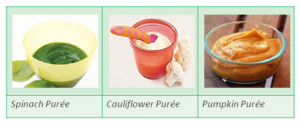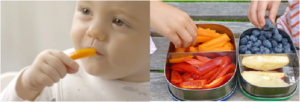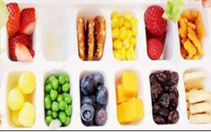Last Updated on October 21, 2025 by
Food supplementation:
Stage-1 (At 6 months) – Food supplementation:
The last step is first to make food pureed i.e. after preparation, they should be beaten in a mortar and later passed through a strainer in order to obtain a very smooth paste or liquid which is fine, creamy. Pumpkin puree, turnip puree and spinach puree is possible. A puree is a smooth cream of cooked and liquidized fruits or vegetables. At the age of two weeks to commencement of the seventh month, fruit puree may begin to be introduced. Try mashed banana puree, apple puree, and carrot puree, then dal and rice.

Stage-2 (At 7-9 months)
Make a lumpy dish of khichri by combining green veggies and mashed potatoes. Offer foods of each food group, including fruit, vegetables, cereals, legumes, pulse, dairy foods like cheese and yogurt, meat, and fish, and eggs, and fats and oil.

Stage-3 (At 9 months onwards)
Foods should be coarsely minced so the infant may pick them up with her thumb and finger.

Right Taste of food:
The newborn experiences taste during its fetal stage. You want to minimise the promotion of salty or sugary foods in moderation — packaged foods from cookies, chips and biscuits. Offer a variety of choices as regards to food flavor.
Right Consistency :
During the time of starting of complementary feeding, appropriate consistency may be adopted to guarantee the optimal nutrition for the child. The food shouldn’t be overly thick or too runny in nature.

Be careful with small beans, pea nuts and Raisins. Choking may result from these. Please attend your toddlers when they need you.
Recommended quantity of solid food for the child:
Gradually, different solid foods to be started for the child diet. To watch for any allergic reactions, simply introduce one new food at a time and keep it that way for three to four days. Stop eating right away and wait a month or two before beginning if you get any rashes, vomiting, or loose motion. (Food supplementation)
Give the infant no more than a teaspoon of the food at first, then a tablespoon, and finally two to three teaspoons.
Prioritize the active time of baby always. Please don’t be in hurry mood to finish the food what you’ve made for baby. The baby may simply throw up everything if you force-feed her, so pause and try again the following day for a better chance.
Make feeding time a joy to the infant and not an exercise in the feeding process. You shouldn’t worry, if the child after eating a spoonful of the meal & then loses interest, in such case please provide breast milk for all the nutrition baby needs.

Suggestive points during complementary feeding:
There is a necessary intake of equal food between boys and girls.
Wash your hands with soap and water, and your child’s hands, before and after feeding.
When the youngster is eating, sit with them.
As per availability in our culture and society, we should select the best complimentary foods t which are simple to cook at home. Also the principles of proper consistency, texture and flavor may be adhered.
Coping technique with difficult eating behavior :
Until the age of one year, children are likely to experience any type of tastes and other tastes. However, in the second year, children develop a time when they are doubtful of new meals. This could continue to the third year of the child’s life The fact that this is a typical stage of a child’s development and that attempting to force feed a child can result in lifelong food refusal should be understood by parents. Do not forget to remove any uneaten food without making a comment.
Self-feeding should be encouraged from an early age for Food supplementation
At mealtimes, the child should be allowed to create a mess. A child should look forward to mealtimes.
During the mealtimes, please pay attention to child.
We must prepare and provide a variety of diet options & honor the preference of baby.
In front of your child, eat the meal you want them to consume.
Ensuring your toddler to eat sufficient, please serve food to him/her in a different bowl.
Food Allergies :
One by one, the foods that are most likely to trigger an allergic reaction should be introduced so that it is simple to determine whether a particular item has triggered a reaction. We may start & introduce such types of diet as soon as our infant is eating fruit, veggies & cereals.
Foods made from cow’s milk or formula are among them; foods based on
Eggs, fish, almonds, soybeans, sesame seeds, mustard seeds, celery, wheat—bread, pasta, and some breakfast cereals—and other meals that contain sulfur, including packaged goods. Cow’s milk shouldn’t be provided before the first birthday, though.
Step -1 :
Six months should be time to offer your baby vegetables. As it is new to the baby, they won’t adopt & learn overnight, but if we persist, we should pass them a passion that will burn brightly for life. We must try to avoid the baby from sweeten vegetables by adhering to broccoli, spinach & cauliflower and also start with one savory flavor of diet.
Green veggies are my lifelong favorite : Food supplementation:
During introduction of complementary food, we should focus our infant to more vegetable flavors instead of sweet types which may help to mold their tastes and instill a lifelong appreciation of green veggies. Even though kids have a natural preference for sweet foods, exposing them to single-vegetable, basic flavors now can help them develop a liking for these foods later in life. In the first step, don’t forget to start with one vegetable and then go on to other single veggies.

Cleanliness is the most important :
Bacteria and germs won’t be present in infant meals if the kitchen is kept clean. Here is few tips to keep our kitchen clean.
Sanitation and hygiene is very much important before you start preparing the food for baby. In first step, we have to wash our hands thoroughly with soap & water. Hence, even for different organic vegetable & its produces that you are going to peel should also be properly washed with clean water.
We should use different working surfaces and equipment during keeping any raw meat, poultry and fish, it should not be mixed with cooked items.
Step – 2 : Food supplementation:
Fruit Puree: just after two to three weeks of consuming just vegetable puree. The other week after supplemental meals were initiated

Soft finger foods together with thicker purees and soft mashed foods are appropriate foods for six to seven month-old. It helps your child develop the speech-related muscles and encourages them to be more adventurous with eating. In the same dinner, serve two or three family vegetables. The infants will understand different food tastes when puree ingredients remain separate from each other.
You should avoid consuming the allergy-trigging items like fish eggs milk and ground nuts and wheat for babies under nine months of age. However, before the first birthday, cow’s milk shouldn’t be administered.
After pureed food, go on to mashed food, and finally solid food. This enhances their ability to chew until at least the second birthday.
Step -3:
At 8 to 9 months, the following should be on the food plate:
1) fruits,
2) Especially many types of green leafy vegetables
3) The dietary choices such as ragi along with rice and wheat belong to the grain group.
4) The diet of a baby should include fish as well as fully cooked eggs and pulses (dal). Additionally they need proteins.
5) These dairy products consist of cheese in combination with curd and butter among others.
6) Fats and oils.
Along with finger foods, food should be prepared and served semi-solid. The messages on the plate for baby’s meals must be in checks and texture.
Your child will not need any forced meals of vegetable purees since you may present tasty small foods like sweet potatoes and bananas for self-feeding. Their experience with food becomes more vibrant regarding colors and flavors and sensory opportunities for Food supplementation

A 9-month-old child requires a plate containing food from each group but also needs visual and sensory diversity in terms of both appearance and texture and smell.
Finger Foods:
Support the fingers after 9 mths of age to take food to his/her mouth.

Foods to serve to children aged 9 to 12 months and older :

Grains: Food supplementation:
Other infant cereals include maize, millet, and baby rice, wheat, ragi, suji, khichri, chapatti, and meals prepared from rice (Idli, Upma).

Protein: Food supplementation:
Bengal gram, chickpeas (Kabuli Chana), lentils, legumes, ground nuts, soybeans, and green peas.Eggs (hard-boiled), fish (bones removed),
Fruits:
Papaya, bananas, apples, mangos and other fruits in seasons, etc.
Vegetables :
Lettuce(salad patta), fenugreek leaves(methi), carrot, pumpkin, tomato, bottle gourd(lauki), spinach(palak), green beans and coriander(dhania)

Dairy :
Paneer cheese, curd & butter etc.
Fats & Oils :
Mix groundnut oil with mustard oil or mustard oil with rice bran oil.
FAQs:
Q1. What is the necessity of food supplementation during the seventh month?
Ans. After six months of age, the breast milk does not contain enough nutrients necessary to support the growing baby because it is deficient of iron among other important nutrients.
Q2. I need to determine which food supplementation will be the right first introduction to my baby’s diet?
Ans. An appropriate first diet for iron nutrient absorption includes fortified cereals together with pureed meat meats in addition to lentils and soft fruits and vegetables such as bananas carrots and avocados.
Q3. Which is the correct approach for introducing new food supplementation items to my infant?
Ans. To monitor allergic reactions infants should only receive one new food at a moment followed by a waiting period of 3–5 days for each new addition.
Q4. What foods should I restrict during my first food supplementation introduction?
ans. The feeding schedule should exclude honey since it presents a botulism risk and whole nuts pose a choking hazard and should limit main beverages to cow’s milk and restrict food additions of salt or sugar.
Q5. How much food supplementation should be given on a daily basis to a 6-month-old infant?
Ans. Your baby needs one or two tablespoon servings per day at most while showing readiness to eat more (serving amounts).
Q6. Whether consumption of breast milk must be continued when solid food is introduced into diet?
Ans. Babies should maintain breastfeeding while also consuming solids beginning from at least 12 months of age as doctors recommend.
Q7. What is the right texture to give to parents when offering supplementation of baby foods?
Ans. The initial solid foods should be fluid yet pureed with no issues for swallowing. The feeding progression for your baby should start with pureed then mashed foods supplementation followed by soft bite-sized foods as your child grows.
Q8. Is the role of iron supplementation should be given priority during the early periods of feeding?
Ans. Very important. The brain needs iron during development to work properly along with anemia prevention so start introducing iron-rich foods supplementation right away.
Q9. Which techniques can I use to ensure my dinner time with my infant is positive?
Ans. Families are advised to add several colorful foods to their child’s schedule, while the caregiver should have patience during eating and remain relaxed when the child learns to grab food alone.
Guideline of WHO for Dengue Disease and its link as mentioned below: https://www.who.int/news-room/fact-sheets/detail/infant-and-young-child-feeding
Thanks and Regards
About the Author – “Mr. Bibhu Ranjan Mund”, Master in Public Health (MPH) from IIHMR University, Jaipur (Rajasthan) has experience of 18 years in Public Health activities. Through “Lovely Health Tips-2025”, we share the evidence & experienced based health & wellness guides with solutions for every day well-being. More from Author
Disclaimer
This information is suggestive only and not a replacement for medical advice. For more detail, please visit to my website as mentioned below:

